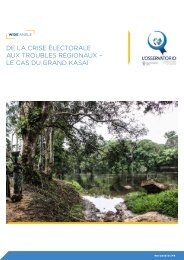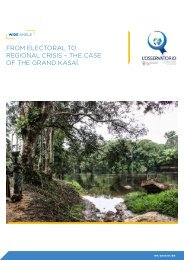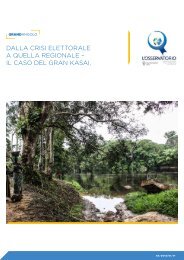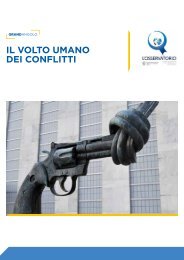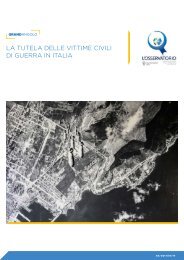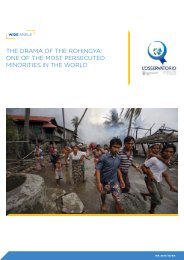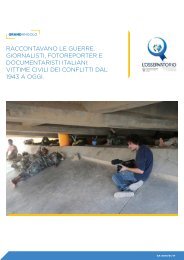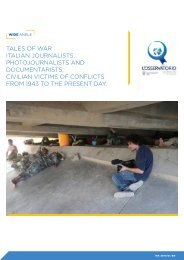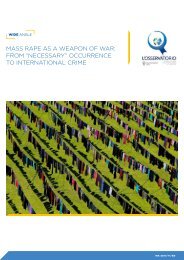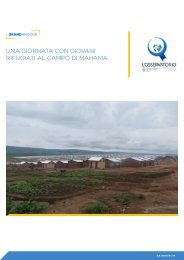The Horror in the Balkans. Civilian Victims in the Second World War in the Former Yugoslavia
You also want an ePaper? Increase the reach of your titles
YUMPU automatically turns print PDFs into web optimized ePapers that Google loves.
<strong>The</strong> conflict <strong>in</strong> <strong>the</strong> <strong>Balkans</strong> and <strong>the</strong> Italian occupation<br />
<strong>The</strong> second world war arrived <strong>in</strong> <strong>Yugoslavia</strong> on 6th April 1941. On that date, on <strong>the</strong> eve<br />
of Palm Sunday, <strong>the</strong> German army moved <strong>the</strong> attack <strong>in</strong> just 11 days and affirmed <strong>the</strong><br />
conquest of <strong>the</strong> k<strong>in</strong>gdom by <strong>the</strong> Axis forces.<br />
<strong>The</strong> Italians <strong>in</strong>vaded <strong>the</strong> Dalmatian coast and occupied Ljubljana on <strong>the</strong> 11th of April.<br />
On <strong>the</strong> 17th, <strong>the</strong> high command of <strong>Yugoslavia</strong> surrendered.<br />
<strong>The</strong> division of <strong>the</strong> <strong>in</strong>vaded lands, which shattered <strong>Yugoslavia</strong> politically as well as<br />
militarily, was as quick as <strong>the</strong> enemy progression.<br />
Italy claimed part of Slovenia and annexed Dalmatia, from Zadar to Split, as well as a<br />
protectorate on Montenegro, Kosovo and <strong>the</strong> western Macedonia. In <strong>the</strong>se territories<br />
lived, <strong>in</strong> different proportions and precarious equilibrium, Slovenes, Croats, Serbs, Italians,<br />
Montenegr<strong>in</strong>s, Albanians and Macedonians, toward which were applied policies<br />
of fascist <strong>in</strong>doctr<strong>in</strong>ation and attempts of denationalisation. 1 <strong>The</strong> rema<strong>in</strong><strong>in</strong>g part of <strong>the</strong><br />
Yugoslav territories were divided between Germany, Bulgaria and Hungary. F<strong>in</strong>ally,<br />
<strong>the</strong> Independent State of Croatia (NDH – Nezavisna Država Hrvatska) was created,<br />
<strong>in</strong>clud<strong>in</strong>g Croatia-Slavonia and Bosnia and Herzegov<strong>in</strong>a (that was occupied <strong>in</strong> <strong>the</strong><br />
summer of 1941 by <strong>the</strong> Italian army) and some Dalmatian islands (Pag, Barc and Hvar).<br />
In this way <strong>the</strong> fascist government fulfilled its expansionist <strong>in</strong>tents on <strong>the</strong> Balkan’s territories,<br />
<strong>the</strong> same that was precluded at <strong>the</strong> end of <strong>the</strong> first world war and that had allowed<br />
Mussol<strong>in</strong>i to feed <strong>the</strong> myth of <strong>the</strong> “mutilated victory”. <strong>The</strong> regime’s propaganda<br />
had s<strong>in</strong>ce <strong>the</strong>n encouraged a revisionist political action that focused on <strong>the</strong> return of<br />
what Italy “legitimately” deserved: or ra<strong>the</strong>r, us<strong>in</strong>g a s<strong>in</strong>ister analogy to Nazi vocabulary,<br />
what was def<strong>in</strong>ed as Italian “vital space” on <strong>the</strong> eastern borders. 2 In order to claim<br />
that legitimacy, racial motivations were associated with historical and geopolitical<br />
reasons. “Italy is <strong>the</strong> only Mediterranean country of <strong>the</strong> Aryan race. This is enough to<br />
expla<strong>in</strong> to anyone who has a culture, that it naturally possesses a prom<strong>in</strong>ent position<br />
<strong>in</strong> <strong>the</strong> Great Internal Sea”. 3 – wrote Giovanni Ansaldo <strong>in</strong> January 1941.<br />
In 1941 Italy, supported by <strong>the</strong> powerful German ally, benefited from a position of<br />
supremacy <strong>in</strong> <strong>the</strong> occupied territories <strong>in</strong> <strong>the</strong> <strong>Balkans</strong>. In <strong>the</strong>se zones, civilians were<br />
mistreated with violence. At <strong>the</strong> same time a process of strong “Italianization” of <strong>the</strong><br />
population started. This process was even more pa<strong>in</strong>ful for <strong>the</strong> orig<strong>in</strong>al population<br />
because it had been perpetrated by <strong>the</strong>ir worst enemy, <strong>the</strong> fascist regime, ally of <strong>the</strong><br />
Croatian nationalism of Ustaša, who <strong>in</strong> <strong>the</strong> year 1934 committed <strong>the</strong> murder of K<strong>in</strong>g<br />
Alexander I <strong>in</strong> Marseilles. 4<br />
“Here <strong>in</strong> Dalmatia, <strong>in</strong> Split – told Lovre Reić, Croatian partisan, who was fourteen at<br />
<strong>the</strong> time of <strong>the</strong> conflict – “we have always been told that <strong>the</strong> Italians were our enemies.<br />
When I heard <strong>the</strong> news of <strong>the</strong> murder of K<strong>in</strong>g Alexander, I came out of my house<br />
with a knife to go <strong>in</strong> search of a young boy belong<strong>in</strong>g to an Italian wire family; I wanted<br />
to take revenge on him for <strong>the</strong> assass<strong>in</strong>ation of our k<strong>in</strong>g. I didn’t even know what a<br />
k<strong>in</strong>gdom or a social system was, but he was <strong>the</strong> k<strong>in</strong>g of my country and our enemies,<br />
<strong>the</strong> Italians, had killed him”. He was a young man named Pige, who played football<br />
5



